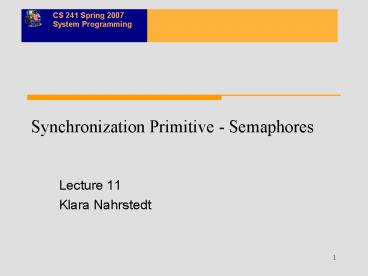Synchronization Primitive Semaphores - PowerPoint PPT Presentation
1 / 21
Title:
Synchronization Primitive Semaphores
Description:
Concurrent processes cannot be overlapped, only interleaved ... errno == EINVAL if semaphore doesnt exist. Semaphore Operations. int sem_trywait(sem_t *sem) ... – PowerPoint PPT presentation
Number of Views:123
Avg rating:3.0/5.0
Title: Synchronization Primitive Semaphores
1
Synchronization Primitive - Semaphores
- Lecture 11
- Klara Nahrstedt
2
CS241 Administrative
- SMP2 Quiz on Monday, 2/12/07
- Read Chapter 5.3 in Stallings Book and Chapter 14
in RR
3
Discussion
- In uni-processor
- Concurrent processes cannot be overlapped, only
interleaved - Process runs until it invokes system call, or is
interrupted - To guarantee mutual exclusion, hardware support
could help by allowing disabling interrupts - While(true)
- / disable interrupts /
- / critical section /
- / enable interrupts /
- / remainder /
- Whats the problem with this solution?
4
Discussion
- In multi-processors
- Several processors share memory
- Processors behave independently in a peer
relationship - Interrupt disabling will not work
- We need hardware support
- The hardware support is based on execution of
multiple instructions atomically - Atomic execution of a set of instructions means
that these instructions are treated as a single
step that cannot be interrupted
5
Test and Set Instruction
6
Usage of Test_And_Set for Mutual Exclusion
- Pi
- while(1)
- while(Test_And_Set(lock))
- / Critical Section /
- lock 0
- / remainder /
- Void main ()
- lock 0
- parbegin(P1,,Pn)
Busy Waiting Issue !!!
7
Semaphore Concept
- Fundamental Principle two or more processes want
to cooperate by means of simple signals - For signaling introduce
- Special Variable Semaphore s
- Primitives
- semSignal(s) transmit signal via semaphore s
- semWait(s) receive signal via semaphore s
- Primitives semSignal and semWait must be
ATOMIC!!! - Note Different notation is used for semSignal
and semWait (P for semWait, V for semSignal,
wait for semWait, signal for semSignal)
8
Definition of Semaphore Primitives (Counting
Semaphore)
- struct semaphore
- int count
- queueType queue
- void semWait(semaphore s)
- s.count--
- if (s.count lt 0)
- place this process in s.queue
- block this process
- void semSignal(semaphore s)
- s.count
- if (s.count 0)
- remove a process P from s.queue
- place process P on ready list
9
Definition of Binary Semaphore Primitives
- struct binary_semaphore
- enum 0,1 value
- queueType queue
- void semWaitB(binary_semaphore s)
- if (s.value 1)
- s.value 0
- else
- place this process in s.queue
- block this process
- void semSignalB(binary_semaphore s)
- if (s.queue is empty())
- s.value 1
- else
- remove a process P from s.queue
- place process P on ready list
10
Mutual Exclusion Using Semaphores
lock 0
- semaphore s 1
- Pi
- while(1)
- semWait(s)
- / Critical Section /
- semSignal(s)
- / remainder /
- Pi
- while(1)
- while(Test_And_Set(lock))
- / Critical Section /
- lock 0
- / remainder /
11
Process
Process
Critical Region
Value of Semaphore lock
B
Queue
A
Normal Execution
Blocked on semaphore lock
1
semWait(lock)
0
semWait(lock)
-1
B
semSignal(lock)
0
semSignal(lock)
1
12
Exercise Exam Question
Consider 2 processes sharing two semaphores S and
Q to protect critical variables a and b.
What happens in the pseudocode if Semaphores S
and Q are initialized to 1 (or 0)?
- process 1 executes
- while(1)
- semWait(S)
- a
- semSignal(Q)
- process 2 executes
- while(1)
- semWait(Q)
- b
- semSignal(S)
13
Implementation of Semaphores in POSIX
- POSIXSEM semaphore is
- variable of type sem_t
- Atomic Operations
- int sem_init(sem_t sem, int pshared, unsigned
value) - int sem_destroy(sem_t sem)
- int sem_post(sem_t sem)
- Int sem_trywait(sem_t sem)
- Int sem_wait(sem_t sem)
- Use ltsemaphore.hgt
14
Unnamed Semaphores Ch 14 pp 491-501
include ltsemaphore.hgt Sem_t sem
You cannot make a copy of a semaphore variable!!!
include ltsemaphore.hgt int sem_init(sem_t sem,
int pshared, unsigned value)
pshared 0 only threads of process creating
semaphore can use semaphore.
15
Sharing Semaphores
- Sharing semaphores between threads within a
process is easy, use pshared0 - Forking a process creates copies of any semaphore
it has this does not share the semaphore - Making pshared non zero allows any process that
can access the semaphore to use it. This places
the semaphore in global environment.
16
sem_init can fail!!!
- In unsuccessful, sem_init returns -1 and sets
errno.
17
Initialization Example
- sem_t semA
- if (sem_init(semA, 0, 1) -1)
- perror(Failed to initialize semaphore semA)
18
Semaphore Operations
include ltsemaphore.hgt int sem_destroy(sem_t
sem)
- Destroying a semaphore thats been destroyed
gives undefined result. - Destroying a semaphore on which a thread is
blocked gives undefined results.
19
Semaphore Operations
- include ltsemaphore.hgt
- int sem_post(sem_t sem)
- signal safe
- can be used in signal handlers
- if unsuccessful, returns -1 and sets errno
- errno EINVAL if semaphore doesnt exist
20
Semaphore Operations
- int sem_trywait(sem_t sem)
- doesnt block
- returns -1 and errnoEAGAIN if semaphore zero
- can be interrupted by signal errno EINTR
- int sem_wait(sem_t sem)
- blocks if semaphore zero
- can be interrupted by signal errno EINTR
21
Summary
- Semaphores
- Semaphore implementation
- POSIX Semaphore
- Programming with semaphores
- S Chapter 5 pp 215-227,
- RRChapter 14 pp488-497































